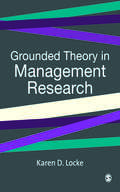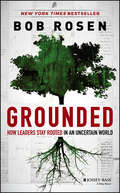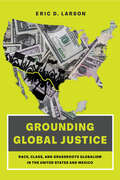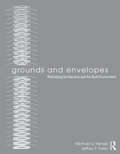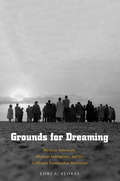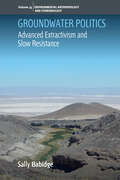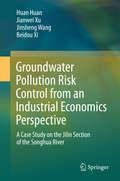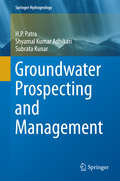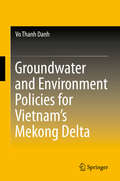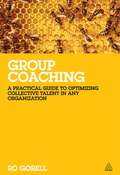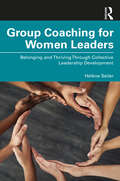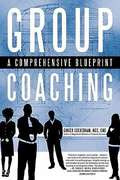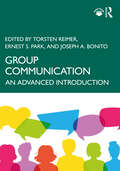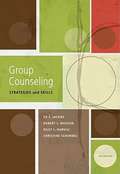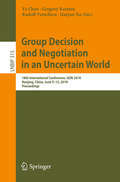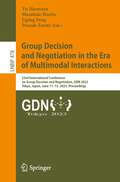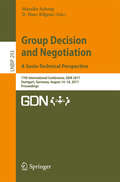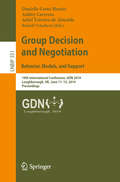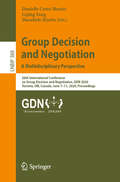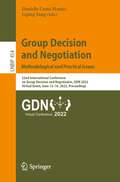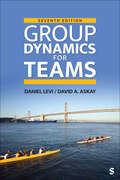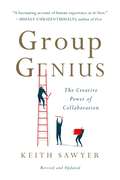- Table View
- List View
Grounded Theory in Management Research (SAGE series in Management Research)
by Karen Locke`This is an excellent text for anyone wishing to explore the possibilities of a grounded theory approach in management and organizational research. The first two parts ought to be essential reading in methods courses, regardless of the field of investigation' - Organization Studies `...resources for conducting grounded theory are spread across a number of disciplines... making it difficult for organization and management scholars to track them down. This book describes the grounded theory approach for organization and management researchers needing to fully understand the possibilities and challenges of this method. It brings together the broadly dispersed discussions of the logic and practices of grounded theory, restoring this style of qualitative research for students and teachers of organization and management' - Management Research News 'Given its content and style of writing, this book will be useful not only to organisational scholars bit also to those such fields as sociology, nursing, education and psychology' - Mihaela Kelemen, Nurse Researcher This book describes the grounded theory approach for organization and management researchers needing to fully understand the possibilities and challenges of this method. It brings together the broadly dispersed discussions of grounded theory's logic and practices, restoring the grounded theory style of qualitative research for students and teachers of organization and management. This book is particularly useful for graduate students involved in quantitative studies of organizational and managerial life, and for academics teaching research methods courses in management and organization studies.
Grounded: How Leaders Stay Rooted in an Uncertain World
by Bob RosenA provocative, personal approach to leadership based on in-depth research with hundreds of executives around the world Confronted by disruptive change and economic turbulence, many of today's leaders find themselves ill-equipped to manage the hazards they now face. They must contend with chronic uncertainty, cynical employees, and personal burnout. Most are poorly served by the prevailing paradigm that obsessively focuses on what we do to produce short-term results while sabotaging who we are as healthy human beings. Few have seen alternatives, until now. Grounded proposes a new approach that's designed for actual humans who must grapple with these forces. This new paradigm speaks to our better selves. Based on the author's Healthy Leader model, it focuses on the six personal dimensions that fuel--and refuel--the world's top leaders: physical, emotional, intellectual, social, vocational, and spiritual health. The book argues that leaders at every level can be more self-aware, develop their untapped potential, and drive significantly better results--for themselves, their teams, and their organizations. Shows readers how to build a personal leadership model that works with their values, goals and capabilities Features fresh stories from leaders in a variety of organizations including the New York Fire Department, PricewaterhouseCoopers, The Lego Group, and Medstar Health Gives leaders practical tools to face their toughest challenges with greater skill, confidence, and impact By developing themselves and mastering the six dimensions, readers can gain the stamina and strength to not only weather tough times but to achieve much, much more.
Grounding Global Justice: Race, Class, and Grassroots Globalism in the United States and Mexico
by Eric D. LarsonThe rise of Trumpism and the Covid-19 pandemic have galvanized debates about globalization. Eric D. Larson presents a timely look at the last time the concept spurred unruly agitation: the late twentieth century. Offering a transnational history of the emergence of the global justice movement in the United States and Mexico, he considers how popular organizations laid the foundations for this "movement of movements." Farmers, urban workers, and Indigenous peoples grounded their efforts to confront free-market reforms in frontline struggles for economic and racial justice. As they strove to change the direction of the world economy, they often navigated undercurrents of racism, nationalism, and neoliberal multiculturalism, both within and beyond their networks. Larson traces the histories of three popular organizations, examining the Mexican roots of the idea of food sovereignty; racism and whiteness at the momentous Battle of Seattle protests outside the 1999 World Trade Organization meetings; and the rise of dramatic street demonstrations around the globe. Juxtaposing these stories, he reinterprets some of the crucial moments, messages, and movements of the era.
Grounds and Envelopes: Reshaping Architecture and the Built Environment
by Michael U. Hensel Jeffrey P. TurkoProviding a source of vision for the revitalisation of ground and envelope as spatial elements that can inform the search for embedded locally specific architectures, this book collects essays and projects that each contributes a particular element to what might constitute an integrated and richly nuanced approach to spatial organisation. Projects include: Paulo Mendes da Rocha; Brazilian Pavilion, Osaka World Expo 1970, Osaka, Japan RCR Arquitectes: Marquee at Les Cols Restaurant, Olot, Girona, Spain Weiss / Manfredi; Seattle Art Museum: Olympic Sculpture Park, Seattle, Washington, USA Peter Eisenman; City of Culture of Galicia, Santiago de Compostela, Spain Plasma Studio and Groundlab; Xi’an Horticultural Expo, Longgang, China Foreign Office Architects; Yokohama International Ferry Terminal, Yokohama, Japan Nekton Design; Turf City, Reykjavik, Iceland Alvaro Siza; Swimming Pool, Leça da Palmeira, Portugal Eduardo Souto de Moura; Braga Municipal Stadium, Braga Portugal MVRDV; Villa VPRO, Hilversum, Netherlands Bernard Tschumi; Le Fresnoy Art Centre, Tourcoing, France OCEAN; World Centre for Human Concerns, New York City, USA R&Sie(n); Spidernethewood, Nîmes, France Toyo Ito; Serpentine Pavilion, London, England Enric Miralles and Carme Pinós; Olympic Archery Range, Barcelona, Spain Kengo Kuma; GC Prostho Museum Research Centre, Aichi Prefecture, Japan Cloud 9; MediaTic, Barcelona, Spain Diller, Scofidio and Renfro; Blur Building, Yverdon-les-Bains, Switzerland, Swiss National Expo With an abundance of built and un-built key projects available, it is now possible to outline the contours of a new discourse. This book initiates a new beginning in this direction so that architecture can partake in the creation of heterogeneous space and culturally, socially and environmentally sustainable built environments.
Grounds for Dreaming
by Lori A. FloresAn incisive study of labor, migration, race, gender, citizenship, and class, Lori Flores’s first book offers crucial insights for today’s ever-growing U.S. Latino demographic, the farmworker rights movement, and future immigration policy.
Groundswell, Expanded and Revised Edition
by Charlene Li Josh BernoffCorporate executives struggle to harness the power of social technologies. Twitter, Facebook, blogs, YouTube are where customers discuss products and companies, write their own news, and find their own deals but how do you integrate these activities into your broader marketing efforts? It's an unstoppable groundswell that affects every industry -- yet it's still utterly foreign to most companies running things now.When consumers you've never met are rating your company's products in public forums with which you have no experience or influence, your company is vulnerable. In Groundswell, Josh Bernoff and Charlene Li explain how to turn this threat into an opportunity.In this updated and expanded edition of Groundswell, featuring an all new introduction and chapters on Twitter and social media integration, you'll learn to:· Evaluate new social technologies as they emerge· Determine how different groups of consumers are participating in social technology arenas· Apply a four-step process for formulating your future strategy· Build social technologies into your businessGroundswell is required reading for executives seeking to protect and strengthen their company's public image.
Groundwater Politics: Advanced Extractivism and Slow Resistance (Environmental Anthropology and Ethnobiology)
by Sally BabidgeThe mining industry is an expanding socio-ecological and political problem worldwide, not least in Atacameño-Likanantay (Indigenous) territories in the hyper-arid Salar de Atacama, Chile. Groundwater Politics addresses the social, technical and political conditions it calls ‘advanced extractivism’ to reveal how groundwater extraction sustains both ecological damage and mining economies. It richly describes the area's copper and lithium industries as historically linked with Indigenous communities and their ecological and economic futures. Based on over a decade of ethnographic research, the book casts community strategies to control water and territory as 'slow resistance’, the structural and multifaceted practices that generate a material future amid potential resource exhaustion.
Groundwater Pollution Risk Control from an Industrial Economics Perspective: A Case Study On The Jilin Section Of The Songhua River (SpringerBriefs in Environmental Science)
by Beidou Xi Huan Huan Jianwei Xu Jinsheng WangThis book argues that groundwater pollution risk assessment is the essential foundation of groundwater pollution prevention and control. It is on this basis that economic leverage is used to make new breakthroughs in groundwater protection and governance. Presenting a case study on the Jilin Section of the Songhua River, the book applies the overlay index method to assess the shallow groundwater pollution risk and identify high-risk areas and major pollution sources in an effort to identify the mechanism of interaction between industrial structures and groundwater pollution. Further, it proposes concrete measures for preventing and controlling groundwater pollution from an industrial economics perspective. As such, the book offers a valuable resource for all graduate students, lecturers and researchers who are interested in learning about resources and environmental economics.
Groundwater Prospecting and Management
by H. P. Patra Shyamal Kumar Adhikari Subrata KunarThe book provides an elaborate treatment of groundwater prospecting and management covering remote sensing, geological-geophysical cum hydrogeological studies, exploration (geological and geophysical), development (well logging techniques, pump test, its analysis and applications in well design), contamination (pollution of groundwater) and regulatory legislations regarding groundwater utilization under one cover. The book presents an elucidation of fundamental and theoretical background of each technique supported by necessary illustrative examples and exclusive case studies. It is a text-cum-reference book not only for students, research scholars and practicing earth scientists but also for practicing civil and agricultural engineers working in the application of groundwater resources, engaged in its exploration, development, contamination, legislation and management. The general readers can also refer the book for understanding the groundwater domain for adequate knowledge, as groundwater resources are essential life support commodity which is replenishable but not inexhaustible.
Groundwater and Environment Policies for Vietnam’s Mekong Delta
by Vo Thanh DanhThis book provides an in-depth analysis of groundwater uses and environmental issues in the Mekong Delta. It focuses on groundwater pollution and use, urban flooding, living with flood policy, and climate change-related adaptation measures. The Mekong Delta is facing these serious issues in the course of its development.This book uses economic analysis methods such as risk cost benefit analysis, cost effectiveness analysis, contingent valuation method, economic loss valuation, and multi criteria analysis to provide policy makers and researchers a better understanding of issues faced by sea level rise-impacted regions around the world and provide possible solutions. Students of environmental economics, economic valuation, and public policy can use this work to enhance their analytical skills.
Group Coaching
by Ro GorellGroup Coaching is a practical guide to developing effective group coaching practice to develop and grow talent.Based on over 40 years of HR, consulting and coaching practical experience, it provides a framework of best practice supported by a range of tried and tested group exercises and tools.With tools and case studies throughout it will provide everything you need to run successful group coaching sessions effectively and develop group coaching as a way of liberating talent throughout any organisation.
Group Coaching for Women Leaders: Belonging and Thriving Through Collective Leadership Development
by Hélène SeilerThis book is an invaluable resource for those looking to lead high-functioning women groups, and a testament to the power of group coaching for women leaders.Dr. Hélène Seiler advocates for the expansion of group coaching to support the fulfilment of women leaders, providing a comprehensive review of the relevant academic literature on group coaching for women leaders and an in-depth analysis of her reflective notes over the last 15 years. This book shares the author’s experience as an international group coach and an executive coach for women leaders, and echoes the voices of her former group members. Using case studies and practical tips, the author offers recommendations when forming a new collective of women leaders, shares best practices in high-functioning groups, provides solutions when dealing with breakdowns within a group, and provides guidelines to lead change when a group composition evolves. This book also addresses the potential impact of technology and artificial intelligence on the stakeholders of group coaching. Each chapter contains key points, multi-cultural case studies, and ends with reflective questions to enrich and personalize the reader’s learning experience.Group Coaching for Women Leaders is an essential resource for group coaches working with women leaders internationally, for academic leaders looking to extend their offerings for student coaches, and for corporate sponsors interested in augmenting the power of women leadership development initiatives in their organizations.
Group Coaching: A Comprehensive Blueprint
by Ginger CockerhamThis book focuses on how a professional coach can create a successful and sustainable business by coaching groups.
Group Communication: An Advanced Introduction
by Torsten Reimer Ernest S. Park Joseph A. BonitoIn this comprehensive, advanced introduction to group communication, the field’s leading experts summarize theory, methodological advancements, and current research in the field. This book follows a coherent structure specifying clear objectives and evidence-based practical implications for the management of groups. Each chapter provides case study examples highlighting the role of communication for group functioning. The textbook takes a particular look at recent advancements in the research on virtual teams, the role of technology in group communication, and issues of diversity and inclusion, considering group communication in various situations including health and organizational contexts. It features theory-driven descriptions, an emphasis on empirical findings, and reflections on research methods. The book is an integrative and coherent textbook for advanced undergraduate and graduate group communication classes and a useful reference for students, scholars, and group communication professionals across different disciplines including communication studies, psychology, life sciences, business administration, management, and engineering. Online resources include a sample course syllabus, discussion questions, lecture slides, and a test-bank. They are available at www.routledge.com/9781032114712
Group Counseling: Strategies and Skills (Seventh Edition)
by Ed E. Jacobs Robert L. L. Masson Riley L. Harvill Christine J. SchimmelThis widely used and respected book presents an active, multisensory approach to group leading, focusing heavily on group leadership skills. While written with the counselor in mind, GROUP COUNSELING: STRATEGIES AND SKILLS, 7th Edition also provides an outstanding discussion of group dynamics for professionals in group leadership positions. The authors discuss the many facets of group counseling and provide examples that show how each skill can be applied in a wide range of group settings to produce efficient working groups.
Group Decision and Negotiation in an Uncertain World: 18th International Conference, GDN 2018, Nanjing, China, June 9-13, 2018, Proceedings (Lecture Notes in Business Information Processing #315)
by Rudolf Vetschera Haiyan Xu Ye Chen Gregory KerstenThis book constitutes the refereed proceedings of the 18th International Conference on Group Decision and Negotiation, GDN 2018, held in Nanjing, China, in June 2018. The field of Group Decision and Negotiation focuses on decision processes with at least two participants and a common goal but conflicting individual goals. Research areas of Group Decision and Negotiation include electronic negotiations, experiments, the role of emotions in group decision and negotiations, preference elicitation and decision support for group decisions and negotiations, and conflict resolution principles.The 15 full papers presented in this volume were carefully reviewed and selected from 143 submissions. They were organized in topical sections named: theoretical concepts of group decision and negotiation; decision support and behavior in group decision and negotiation; and applications of group decision and negotiations.
Group Decision and Negotiation in the Era of Multimodal Interactions: 23rd International Conference on Group Decision and Negotiation, GDN 2023, Tokyo, Japan, June 11–15, 2023, Proceedings (Lecture Notes in Business Information Processing #478)
by Pascale Zaraté Liping Fang Masahide Horita Yu MaemuraThis book constitutes the refereed proceedings of the 23rd International Conference on Group Decision and Negotiation, GDN 2023, which took place in Tokyo, Japan during June 11–15, 2023.The field of Group Decision and Negotiation focuses on decision processes with at least two participants and a common goal but conflicting individual goals. Research areas of Group Decision and Negotiation include electronic negotiations, experiments, the role of emotions in group decision and negotiations, preference elicitation and decision support for group decisions and negotiations, and conflict resolution principles. This year’s conference focusses on multimodal interactions. The 11 full papers presented in this volume were carefully reviewed and selected from 102 submissions. They were organized in the following topical sections: Taking a step back: Critically re-examining technology interactions with group decision and negotiation; preference modeling and multi-criteria decision-making; and conflict modeling and distributive mechanisms.
Group Decision and Negotiation. A Socio-Technical Perspective: 17th International Conference, GDN 2017, Stuttgart, Germany, August 14-18, 2017, Proceedings (Lecture Notes in Business Information Processing #293)
by D. Marc Kilgour Mareike SchoopThis book constitutes the refereed proceedings of the 17th International Conference on Group Decision and Negotiation, GDN 2017, held in Stuttgart, Germany, in August 2017. The field of Group Decision and Negotiation focuses on decision processes with at least two participants and a common goal but conflicting individual goals. Research areas of Group Decision and Negotiation include electronic negotiations, experiments, the role of emotions in group decision and negotiations, preference elicitation and decision support for group decisions and negotiations, and conflict resolution principles.The 14 full papers presented in this volume were carefully reviewed and selected from 87 submissions. They were organized in topical sections named: general topics in group decision and negotiation; conflict resolution; emotions in group decision and negotiation; negotiation support systems and studies; and preference modeling for group decision and negotiation. The book also contains two invited talks in full paper length.
Group Decision and Negotiation: 19th International Conference, GDN 2019, Loughborough, UK, June 11–15, 2019, Proceedings (Lecture Notes in Business Information Processing #351)
by Adiel Teixeira de Almeida Rudolf Vetschera Danielle Costa Morais Ashley CarrerasThis book constitutes the refereed proceedings of the 19th International Conference on Group Decision and Negotiation, GDN 2019, held in Loughborough, UK, in June 2019. The field of Group Decision and Negotiation focuses on decision processes with at least two participants and a common goal but conflicting individual goals. Research areas of Group Decision and Negotiation include electronic negotiations, experiments, the role of emotions in group decision and negotiations, preference elicitation and decision support for group decisions and negotiations, and conflict resolution principles. The 17 full papers presented in this volume were carefully reviewed and selected from 98 submissions. They were organized in topical sections named: preference modeling for group decision and negotiations; collaborative decision making processes; conflict resolution; behavioral OR, and negotiation support systems and studies.
Group Decision and Negotiation: 20th International Conference on Group Decision and Negotiation, GDN 2020, Toronto, ON, Canada, June 7–11, 2020, Proceedings (Lecture Notes in Business Information Processing #388)
by Liping Fang Danielle Costa Morais Masahide HoritaThis book constitutes the refereed proceedings of the 20th International Conference on Group Decision and Negotiation, GDN 2020, which was planned to be held in Toronto, ON, Canada, during June 7–11, 2020. The conference was cancelled due to the Coronavirus pandemic. Nevertheless, it was decided to publish the proceedings, because the review process had already been completed at the time the cancellation was decided. The field of Group Decision and Negotiation focuses on decision processes with at least two participants and a common goal but conflicting individual goals. Research areas of Group Decision and Negotiation include electronic negotiations, experiments, the role of emotions in group decision and negotiations, preference elicitation and decision support for group decisions and negotiations, and conflict resolution principles. The 14 full papers presented in this volume were carefully reviewed and selected from 75 submissions. They were organized in topical sections named: Conflict Resolution, Preference Modeling for Group Decision and Negotiation, Intelligent Group Decision Making and Consensus Process, Collaborative Decision Making Processes.
Group Decision and Negotiation: 22nd International Conference on Group Decision and Negotiation, GDN 2022, Virtual Event, June 12–16, 2022, Proceedings (Lecture Notes in Business Information Processing #454)
by Liping Fang Danielle Costa MoraisThis book constitutes the refereed proceedings of the 22nd International Conference on Group Decision and Negotiation, GDN 2022, which was held virtually during June 12–16, 2022. The field of Group Decision and Negotiation focuses on decision processes with at least two participants and a common goal but conflicting individual goals. Research areas of Group Decision and Negotiation include electronic negotiations, experiments, the role of emotions in group decision and negotiations, preference elicitation and decision support for group decisions and negotiations, and conflict resolution principles. This year’s conference focusses on methodological and practical issues. The 9 full papers presented in this volume were carefully reviewed and selected from 68 submissions. They were organized in the following topical sections: Preference modeling for group decision and negotiation; conflict resolution; collaborative decision making processes.
Group Dynamics for Teams
by Daniel J. Levi David A. AskayGrounded in psychology research but with a practical focus on organizational behavior issues, Group Dynamics for Teams, Seventh Edition helps readers understand and participate in teams more effectively in day-to-day work. Best-selling authors Daniel Levi and David A. Askay thoroughly examine basic group dynamics concepts, such as goals, norms, cooperation, and communication, as well as review the main challenges that teams face, such as conflict, decision making, problem solving, creativity, and valuing diversity.
Group Dynamics for Teams
by Daniel J. Levi David A. AskayGrounded in psychology research but with a practical focus on organizational behavior issues, Group Dynamics for Teams, Seventh Edition helps readers understand and participate in teams more effectively in day-to-day work. Best-selling authors Daniel Levi and David A. Askay thoroughly examine basic group dynamics concepts, such as goals, norms, cooperation, and communication, as well as review the main challenges that teams face, such as conflict, decision making, problem solving, creativity, and valuing diversity.
Group Functions at the Maersk Group
by Matthew Shaffer David J. CollisIn 2014, seven years after he was appointed CEO of the Danish shipping and oil conglomerate A.P. M ller Maersk (the Maersk Group), Nils Andersen was reexamining the size and role of corporate headquarters in the company he had reshaped as a "premium conglomerate." During his tenure, Andersen had divided what had previously been operated as almost a single entity into separate lines of business, each accountable for its own performance and expected to deal at arms-length with its "sister" businesses, while substantially reducing the size and functions of the corporate headquarters. But as the business units (BUs) and corporate headquarters adjusted to their new roles, new issues surfaced.
Group Genius
by Keith SawyerCreativity has long been thought to be an individual gift, best pursued alone; schools, organizations, and whole industries are built on this idea. But what if the most common beliefs about how creativity works are wrong? Group Genius tears down some of the most popular myths about creativity, revealing that creativity is always collaborative-even when you're alone. Sharing the results of his own acclaimed research on jazz groups, theater ensembles, and conversation analysis, Keith Sawyer shows us how to be more creative in collaborative group settings, how to change organizational dynamics for the better, and how to tap into our own reserves of creativity.
